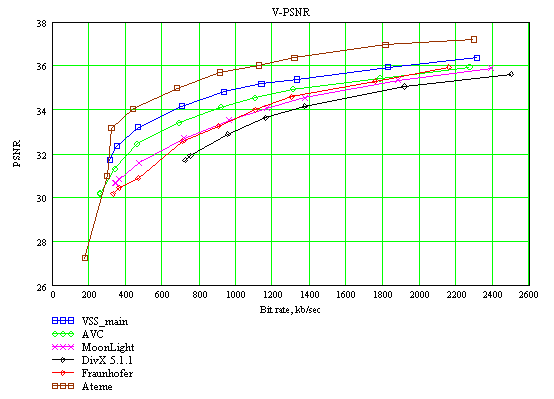First Annual MSU H.264/MPEG-4 AVC Video Codecs Comparison
For professional users and codec authors
See NEW VERSION on Fourth Annual H.264/AVC comparison page!
Also see Selected Comments for First Annual MPEG-4 AVC/H.264 Video Codecs Comparison!
- Project head: Dr. Dmitriy Vatolin
- Testing, charts, analysis: Dmitriy Kulikov, Alexander Parshin
- Translating: Daria Kalinkina
- Verification: Stanislav Soldatov
About comparison
We would like to thank Moonlight Cordless LTD, Fraunhofer Institute for Integrated Circuits IIS and Ateme for kindly providing us their codecs for this test.
Tested codecs:
- Mpegable AVC Codec
- Moonlight H.264 Video Codec
- MainConcept H.264 Codec
- Fraunhofer IIS Codec
- Ateme MPEG-4 AVC / H.264 Codec
- Videosoft H.264 Codec
- DivX Pro 5.1.1 Codec (NOT 264! Used for comparison with H.264 codecs as well tuned codec from previous generation MPEG-4 ASP)
MSU H.264/MPEG-4 AVC Codecs Comparison (3.69Mb, PDF)
Current plans:
- Codec speed comparison.
- Codec compatibility comparison.
- Adding more H.264 codecs to the comparison.
See also Old codec comparison (May 2003) and Lossless codecs comparison (Jan 2005)
Main goals
The main idea is to compare the results provided by the new codecs when they are used by an ordinary user for home video compression. As a rule, such users prefer simple and popular programs to play DVD movies or digitize signal from tuner. Also they rarely change default codec’s settings. We understand that it is very hard to create codecs that would work well on different sequences using the same settings, but this situation is rather common.
Taking the peculiarities of H.264 standard into consideration (such as long time of coding when all possibilities are used) we are going to use 2 presets: “tuned” and “fast”. First one is used to get maximum quality, second one is used to ensure fast processing. These presets will be provided by the codecs developers. Both time and quality will be measured. This will allow codecs to show their possibilities in terms of quality and us to compare speed in a more correct way.
Main parts of the comparison:
- Comparison in Y-PSNR, U-PSNR and V-PSNR metrics.
- Per frame comparison.
- Bit rate handling (does your movie fit on the CD?).
- Visual comparison.
- Informal codecs comparison.
Comparison with PSNR metric
PSNR - is a metric used to compare 2 pictures: the more per pixel difference between the pictures is the less is PSNR value. We use the average value of the per frame PSNR metric to compare two sequences. So the higher is the codec’s line on the graph the better is the quality of compression performed by this codec.
Y-PSNR is the difference in brightness component, U-PSNR and V-PSNR are the differences in hue components.

On this picture V-PSNR values are shown. The higher the line is the better is the quality.
Visual codec comparison
In most cases the PSNR value is in accordance with the compression quality. But sometimes this metric does not reflect presence of some important visual artefacts. For example, we can’t estimate the quality of the blocking artefacts compensation performed by some codec using only PSNR metric. Also in some cases it is difficult to say whether 2 dB difference is significant or not.
That is why we use visual comparison of some frames in addition to the PSNR images. This won`t help us to understand the whole situation, but will allow to demonstrate some interesting features of the codec (e.g. block artifacts compensation).
 Ateme H.264 |
 Divx 5.1.1 |
These pictures present the same frame compressed by two different codecs with the same bitrate. One can see that Ateme H.264 codec provides a better compensation of the blocking artifacts.
Content of HTML version
- Introduction
- Thanks
- Overview
- Goal and testing rules
- Sequences
- Codecs
- PSNR/Bitrate diagrams
- Y-PSNR/Bitrate diagrams
- Delta-Y-PSNR/Bitrate diagrams
- UV-PSNR/Bitrate diagrams
- Additional testing
- Average brightness shift diagrams
- Bitrate handling diagrams
- Per frame sequences comparison
- Visual comparison of H.264 and DivX codecs
- Final part
- Informal codecs comparison
- Common conclusion
Download
- First Annual MSU H.264/MPEG-4 AVC Video Codecs Comparison - PDF (3.69 Mb)
- First Annual MSU H.264/MPEG-4 AVC Video Codecs Comparison - ZIP (3.2 Mb)
If you are interested in your codecs’ testing or tuning, please write to us at videocodec-testing@graphics.cs.msu.ru
Contacts
-
MSU Benchmark Collection
- Video Saliency Prediction Benchmark
- LEHA-CVQAD Video Quality Metrics Benchmark
- Learning-Based Image Compression Benchmark
- Super-Resolution for Video Compression Benchmark
- Video Colorization Benchmark
- Defenses for Image Quality Metrics Benchmark
- Super-Resolution Quality Metrics Benchmark
- Deinterlacer Benchmark
- Metrics Robustness Benchmark
- Video Upscalers Benchmark
- Video Deblurring Benchmark
- Video Frame Interpolation Benchmark
- HDR Video Reconstruction Benchmark
- No-Reference Video Quality Metrics Benchmark
- Full-Reference Video Quality Metrics Benchmark
- Video Alignment and Retrieval Benchmark
- Mobile Video Codecs Benchmark
- Video Super-Resolution Benchmark
- Shot Boundary Detection Benchmark
- The VideoMatting Project
- Video Completion
- Codecs Comparisons & Optimization
- VQMT
- MSU Datasets Collection
- Metrics Research
- Video Quality Measurement Tool 3D
- Video Filters
- Other Projects
